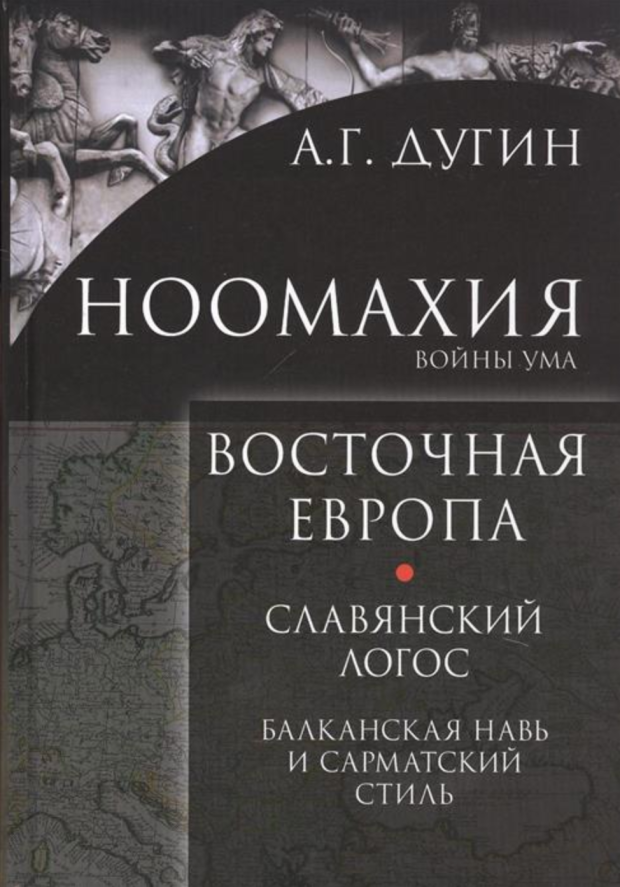Alexander Dugin, Noomakhia – Eastern Europe: The Slavic Logos – Balkan Nav and Sarmatian Style
(Moscow: Academic Project, 2018)

Table of Contents:
PART I: The Civilization of the Goddess and the Peasant Ecumene of Europe
Chapter 1: Eastern Europe as a Geosophical Concept
Chapter 2: The Matriarchal Pole of Eastern Europe
Chapter 3: The Turanian Invasion
PART II: The Eastern European Nav
Chapter 4: The Worlds of Nav and the Gestalt of the Vampire
Chapter 5: The Witch, the Idiot, and the Languages of the Nocturne
Chapter 6: The Indo-European Element: The Homeland of Dionysus
PART III: The Proto-Slavs
Chapter 7: The Structures of Slavic Identity: The Paleo-European Mother and the Indo-European Father
Chapter 8: At the Dawn of Slavic History
PART IV: The South Slavs: Bulgarian Katechon and the Mission of the Bogomils
Chapter 9: The Bulgarian Historial
Chapter 10: The Parallel Historial of Bulgarian Identity
Chapter 11: Macedonia: Gospel of the Vampire
Chapter 12: The Structure of the Bulgarian Logos
PART V: Illyrian Civilization: Fiery Serbia and other South Slavs
Chapter 13: The Serbian Historial
Chapter 14: Bosnia: Bogomils and Islamization
Chapter 15: The Serbian Wail
Chapter 16: In Search of the Serbian Logos
Chapter 17: The Historial of the Croats
Chapter 18: The Croatian Logos: Pan-Slavism and/or Nationalism
Chapter 19: Slovenia
Chapter 20: Slovenian Style: Euro-Integration and Nihilism
PART VI: The West Slavs: The Moravo-Bohemian Logos
Chapter 21: The West Slavs in the Slavic World
Chapter 22: Sources and Flight of the Czech State
Chapter 23: The Czech Logos of the Hussites
Chapter 24: The Czechs and Modernity
Chapter 25: The Philosophy of the Czech Renaissance
PART VII: The Polish Horizon: Sarmatian Spirit and European Mission
Chapter 26: The North-West Slavs in Antiquity
Chapter 27: The Polish Historial
Chapter 28: Old Polish Religion
Chapter 29: Union, Partitions, Modernization, Freedom
Chapter 30: Polish Pride and the Polish Logos: The “Christ of Europe”
Chapter 31: Polish Terror
Chapter 32: The Polish Structure
Conclusion: On the Path Towards the Slavic Ereignis
“Noomakhia is the war in the sphere of the mind. The author of Noomakhia examines human history and the present as a ceaseless war between diverse civilizational projects founded on three noological paradigms (the Three Logoi of Apollo, Dionysus, and Cybele). The panorama of humanity presents in all its fullness and diversity the many dialogues, combinations, juxtapositions, appropriations, and annihilations of the Logoi which yield numerous types of rationality, mythologies, philosophies, religions, metaphysics, and constitute the plurality of civilizational constructs.
The space of Eastern Europe is a frontier between two civilizations – Western European and Russian. Precisely here ran the border between the nomadic, Indo-European, patriarchal civilizations of Turan and the matriarchal civilizations of Old Europe (which emerged in Anatolia and spread to the Balkans and Southern Europe), between the Catholic (Latin) Celto-Germanic West and the Russian-Orthodox East. The mosaic of this pivot region’s peoples and religions has never in history been geopolitically united, but this does not mean that the peoples of Eastern Europe cannot develop civilizational unity in the future and retrieve a cultural identity founded on the common Eastern European Dasein.
Since the fifth-sixth centuries A.D., the Slavic peoples have played a decisive role in the space of Eastern Europe. This volume of Noomakhia examines the Slavic horizon of Eastern Europe, which the author calls “Great Slaviania.” In question is not a concrete polity, but the inner unity of the Slavic Dasein, language, and ethno-sociological structure, constituted by the predominance of the settled agricultural population and the allogenic superstructure of a ruling warrior elite, the latter being an indirect trace of Sarmatian, Turanian, or Germanic influence. Alexander Dugin believes that, despite the powerful impact exerted on Slavic horizon of Eastern Europe by a number of non-Slavic peoples and powerful civilizational poles – such as Byzantium, Rome, Germany, France, England, Russia, and the Ottoman Empire – the mosaic of the West and South Slavic peoples, being the foci of mixed, self-sufficient cultures, can in the future form a multi-faceted and fully-fledged civilizational unity.“

